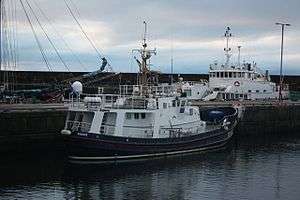Clyde-class lifeboat
The Clyde-class lifeboat was operated by the Royal National Lifeboat Institution (RNLI) from two of its stations in the United Kingdom, Kirkwall and Clovelly. Only three vessels were built for the RNLI, however a fourth vessel was built in the Netherlands to the same lines as 70-001 and 70-003 as a pilot boat for Trinity House.
 RNLB City of Bristol (ON 1030) now Gemini Explorer | |
| Class overview | |
|---|---|
| Builders: |
|
| Operators: |
|
| Cost: |
|
| Built: | 1965–66, 1974 |
| In service: | 1968–1988 |
| Completed: | 3 |
| Retired: | 3 |
| General characteristics | |
| Type: | Motor lifeboat |
| Displacement: | 78–85 tons |
| Length: | 70–71 ft (21–22 m) |
| Beam: | 17–18 ft (5.2–5.5 m) |
| Draft: | 9 ft (2.7 m) |
| Installed power: | Twin Gardner 8L3B 230 bhp (170 kW) diesel engines |
| Propulsion: | Twin screw |
| Speed: | 11.5 knots (21.3 km/h; 13.2 mph) |
| Range: | 1,700 nmi (3,100 km) |
History
Following a visit in the early sixties to lifeboat societies in the Netherlands and West Germany, which successfully employed cruising lifeboats, the RNLI's Management Committee decided to sanction the construction of two such boats for RNLI service. The first two boats went on trials in 1966 and in 1968 went on station at Clovelly and Kirkwall. The third boat was built as a relief but took over as station boat at Clovelly, with the first boat becoming the relief. It eventually became apparent that cruising type boats were not really suited to the RNLI's operations and the boats were used at their respective bases as normal lifeboats until withdrawal in 1988.
Description
The Clyde-class cruising lifeboat was the largest ever built for the RNLI and the first to have a steel hull. The first and second boats differed in hull design, ON 987 having a hull designed by the RNLI's Richard Oakley, 71 feet (22 m) long and with a beam of 18 feet (5.5 m), while the second boat, ON 988, had a hull designed by Irish naval architect John Tyrrell and was 70 feet (21 m) long and with a beam of 17 feet (5.2 m). Both boats had similar superstructure layouts, with a flying bridge. As crews were intended to live on board, berths and messing facilities were provided.
An inflatable inshore boat was carried forward of the wheelhouse. The boats were powered by two 230 brake horsepower (170 kW) Gardner 8L3B 8-cylinder diesel engines driving twin screws. Eight years after the first boat had been built, it was decided to build a third Clyde as a relief boat for the first two. This was based on the Oakley hull design, but featured a completely redesigned superstructure resembling an overgrown Arun.
RNLI fleet
| ON[lower-alpha 1] | Op. No.[lower-alpha 2] | Name | Built | In service | Principal station |
|---|---|---|---|---|---|
| 987 | 70-001 | Charles H Barret (Civil Service No. 35) | 1965 | 1968–1975 1975–1988 |
Clovelly Relief fleet[1] |
| 988 | 70-002 | Grace Paterson Ritchie | 1966 | 1968–1988 | Kirkwall[2][3] |
| 1030 | 70-003 | City of Bristol | 1974 | 1975–1988 | Clovelly |
- ON is the RNLI's Official Number of the boat.
- Op. No. is the RNLI's Operational Number of the boat carried on the hull.
Trinity House fleet
| Name | Built | In service | Service |
|---|---|---|---|
| Lodesman | 1974 | 1974–1988 | Heavy weather pilot vessel |
References
- "Clovelly Lifeboat Station History". RNLI. Retrieved 23 April 2012.
- "Kirkwall Lifeboat Station History". RNLI. Retrieved 23 April 2012.
- "Former Kirkwall lifeboat returns to visit local waters". RNLI. Retrieved 23 April 2012.